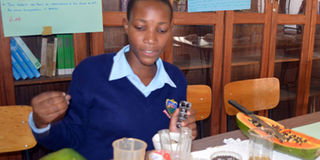Girl, 19, makes deworming tablet

Ms Nalukwago demonstrates how the deworming tablets are made. PHOTO BY AL-MAHDI SSENKABIRWA.
What you need to know:
Innovation. The ‘medicine’, made of dried pawpaw seeds, sugar and cassava flour or banana flour.
“My dream is to become a veterinary doctor but I am also an emerging innovator,” says Christine Nalukwago, the girl behind the research which might lead to the discovery of locally-made de-worming tablets.
Nalukwago, 19, currently a Senior Six student at Kitante Hill School, says she hatched the idea of coming up with a solution to parasitic worms in children while staying with her grandmother.
“My grandmother used to give us dried pawpaw seeds to chew when we were still young but we didn’t know the use. But one day, she told us that they expel worms from our bodies,” she says.
Nalukwago says she became inquisitive after her grandma’s revelation and when she joined secondary school where she has access to laboratories, she chose to carry her research forward.
“At first, the results were not good but I kept on trying,” says Nalukwago, who offers Physics, Chemistry, Agriculture and sub-Math as a subject combination.
How it is done
Nalukwago says some of the substances she mixes to develop the ‘drug’ includes; dried pawpaw seeds, sugar and cassava flour or banana flour.
“I mix them in equal quantity and leave them in a clean open place to concentrate. Sometimes the whole process takes a week when there is enough sunshine or two weeks when there is little sunshine,” Nalukwago explains.
She says after final tests in the laboratory, she tried the drug on a worm and it died instantly.
“I believe my drug is effective and I invite the National Drug Authority to come and test its efficacy,” she said.
Studies both in Uganda and Kenya have shown that children are more infested with worms such as soil-transmitted helminthes such as hookworms.
These worms normally make the children malnourished. The commonly used drug to treat worms is mabendazole.
Nalukwago showcased her innovation recently during the regional Science, Technology, Engineering and Mathematics competition at Gayaza High School where 10 schools from East Africa participated.
Nalukwago’s innovation became the second top science innovative project after a rooftop water harvesting system which was designed by Miriam Nsekenziza and Precise Nyabami of FAWE Girls School -Kigali.
Athwana High School came third place after detailed research on e-waste management. Each of the winners received a cash prize.
Rose Izizinga, the head teacher Kitante Hill School, describes the innovation as a major breakthrough as the institution strives to reclaim its place among the top schools in the country.
“Some people thought making Kitante a free Universal Secondary Education school was the worst decision made but here we are. More is yet to come and I simply encourage my young learners to dream more and do more,” Izizinga says.
Sarah Matovu, one of the judges, says they arrived at the three top projects basing on how practical they are, their originality and the manner in which the students presented them.
“We were looking at how they were presenting the projects and whether they got any assistance from their teachers.”
What experts say
Prof. Charles Kwesiga, the executive director of Uganda Industrial Research Institute, lauded Nalukwago’s inventions and brilliance in science but noted that, her tablets needed critical laboratory examination and empirical examination of the components that were used in coming up with the tablets.
“They are tablets and I cannot rule that out, but they must be first tested, the ingredients and then a scientific explanation arrived at. When approved by our team of laboratory experts and a process through which they work underlined, then they can be medically and scientifically approved for usage.”
According to Martha Muhwezi, the programme manager at Forum for African Women Educationists (FAWE) secretariat, the competition, the first of its kind in the region, is intended to help female learners relate what they learn in class and its applicability in daily life thus building linkage between curriculum topics and needs of the communities.
“There have been many science competitions in the past but this one is unique in the sense that we look at science in a holistic way including technology, engineering and research,” she said.
“Our key goal is to identify outstanding students in innovation and creativity that can solve societal challenges,” Muhwezi adds.
She said the competition will be an annual event using financial support from Intel Corporation -an American technology company, and the world’s largest semiconductor chip maker, based on revenue.
FAWE is a pan-African NGO working in 32 African countries to empower girls and women through gender-responsive education. Many bright but underprivileged girls have received FAWE scholarships and majority of the beneficiaries are those with a science background.




